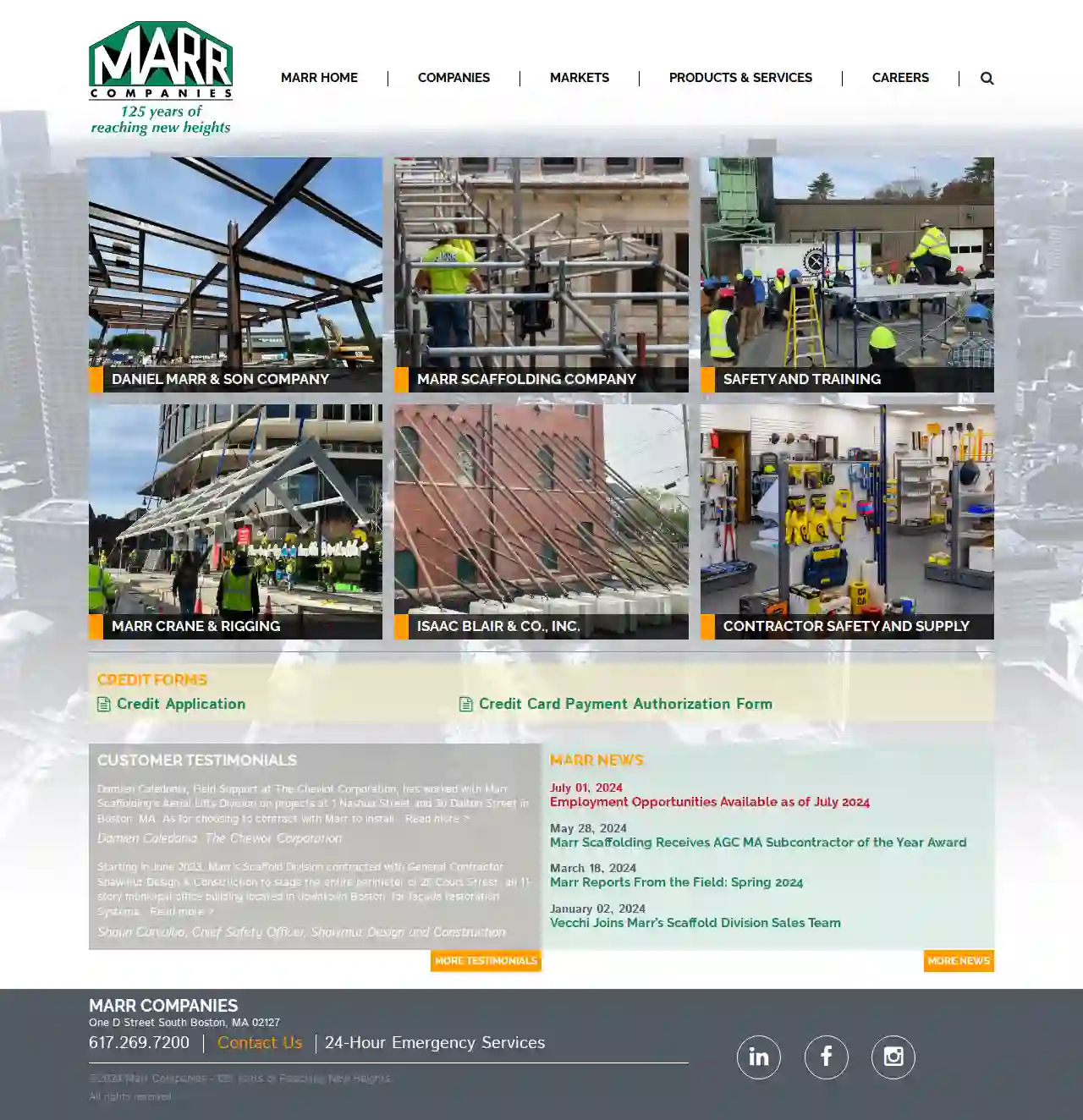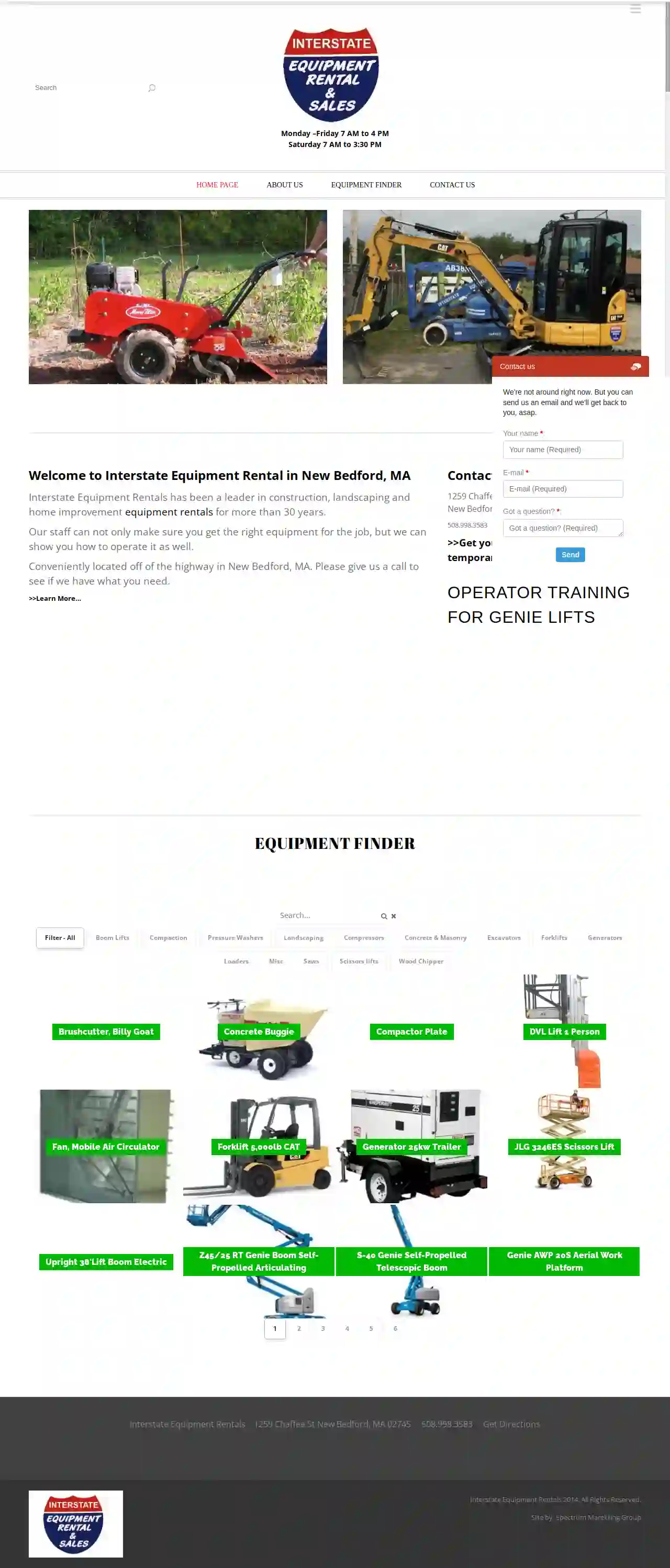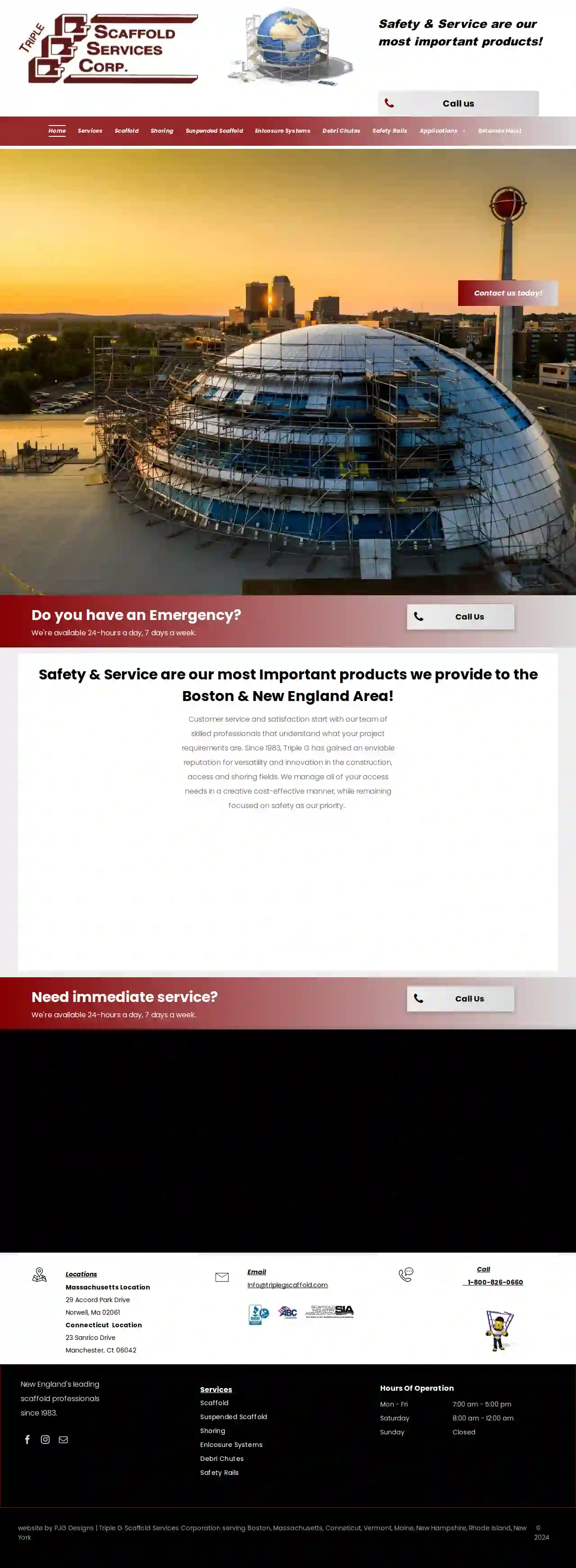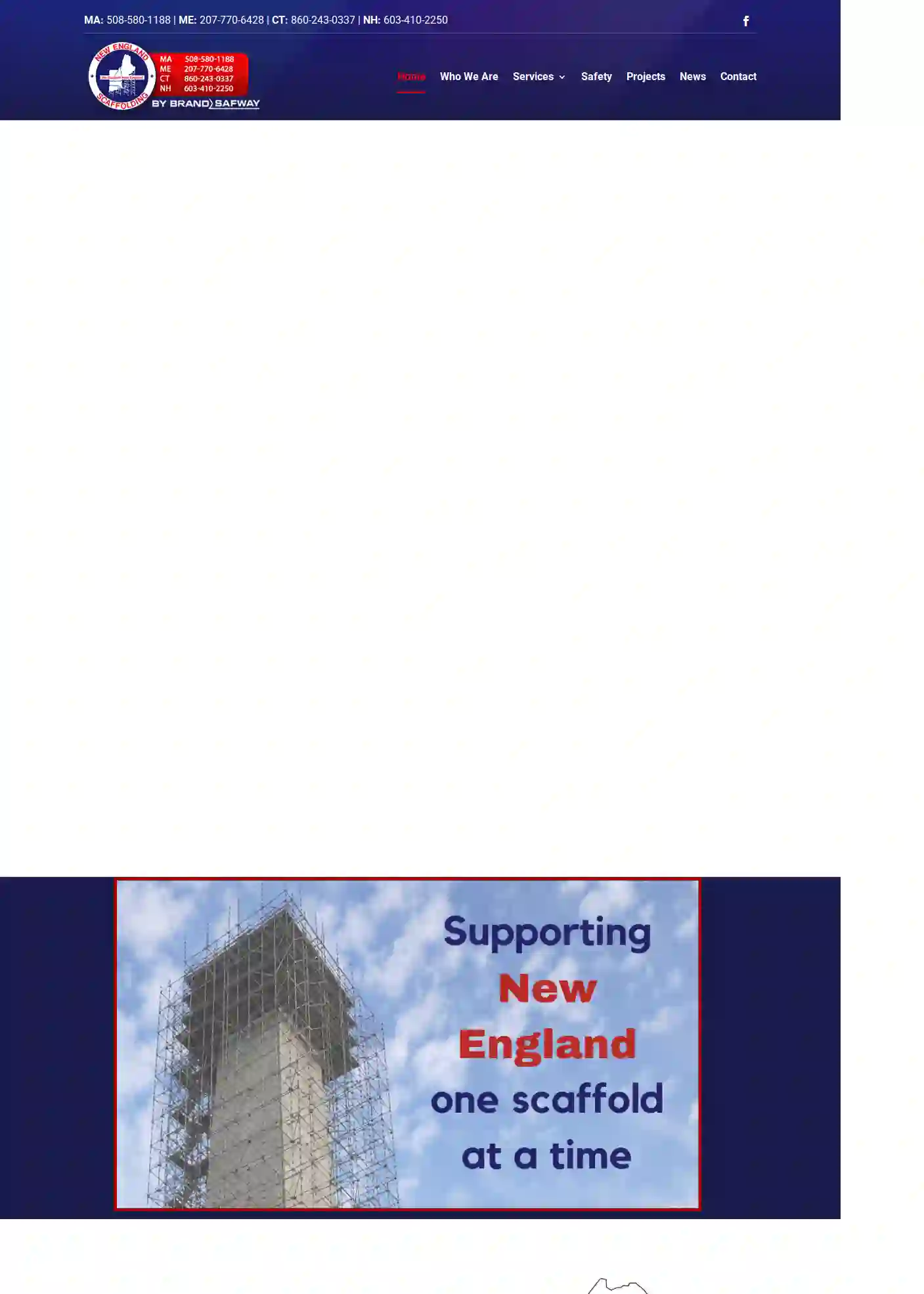Scaffolding Rental Mattapoisett
Find the best Temporary Scaffolding in Mattapoisett
Receive 3 FREE Scaffolding Rental Services quotes for your project today! Compare profiles, reviews, accreditations, portfolio, etc... and choose the best service.

Marr Scaffolding Company
4.421 reviewsBoston, MA, 1 D Street, 02127, USMarr Companies is a leading provider of safety and training solutions, with over 125 years of experience in the industry. Our mission is to provide top-notch services to our clients, ensuring their safety and well-being. We offer a wide range of services, including aerial lifts, aluma joists, angel's wings, bleachers, boom lifts, bracing, building remediation, calibrated jacking, chutes, column replacement, contractor's safety and supply warehouse, construction elevators, cranes, dryair, elevators, emergency services, enclosures, environmental work, erection and dismantling, fall protection products, grandstands, ground thaw, heat wagon, hi-lite, hoists, hydro mobile, ladders, lulls, mast-climbing work platforms, needle shoring, plank, post shores, precast erection, pre-construction planning, redi-fence, rigging, safety, safety products, scaffolding, scissor lifts, sectional scaffold, shore-x, shoring, sidewalk protection, specialty shoring, specialty rigging, steel erection, suspended scaffolds, systems scaffold, temporary heat, temporary seating, trucking, wall bracing, and warehousing. Our team of experts is dedicated to providing the highest level of service and support to our clients. We are fully accredited and insured, and we take pride in our work. We are committed to reaching new heights and providing the best possible solutions to our clients.
- Services
- Why Us?
- Accreditations
- Our Team
- Testimonials
- Gallery
Get Quote
Interstate Equipment Rental & Sales
4.327 reviews1259 Chaffee St, New Bedford, 02745, USWelcome to Interstate Equipment Rental in New Bedford, MA. Interstate Equipment Rentals has been a leader in construction, landscaping and home improvement equipment rentals for more than 30 years. Our staff can not only make sure you get the right equipment for the job, but we can show you how to operate it as well. Conveniently located off of the highway in New Bedford, MA. Please give us a call to see if we have what you need.
- Services
- Why Us?
- Gallery
Get Quote
Commonwealth Scaffold
59 reviews88 Eastern Ave, Malden, 02148, USWe Build Safe, So You Can Build Safer Commonwealth Scaffold, LLC serves Boston and the New England area market and is committed to providing our customers with the highest quality scaffolding products and service. Our History A union company with a focus on safety and bringing innovative solutions to complex jobsites. Commonwealth Scaffold, founded in 2007 by Luke McKinnon and Peter Volpe, is a Boston based scaffolding contractor servicing the New England area with the highest quality scaffolding planning and erection. Our main objective is to deliver safe and innovative solutions to your difficult builds. We use experience, open communications, a safety oriented approach and innovative design to accomplish our clients’ goals and needs. Our extensive portfolio of specialized services includes: scaffolding, coatings, insulation, refractory, formwork and shoring, specialty mechanical services, trash chutes and other related crafts. Our Approach Experience A team with unrivaled experience and leading edge training. Communication Managment that listens to our clients unique challenges and goals. Safety A focus on safety to keep your jobsite injury-free and on schedule. Innovation Solution oriented approach to complex builds and jobsites.
- Services
- Why Us?
- Our Team
- Gallery
Get Quote
Lynn Ladder & Scaffolding Co., Inc.
4.253 reviews25 Fordham Rd, Lynn, 01902, USLynn Ladder was founded in 1946 by Bernie Kline with a mission to provide ladders and scaffolding to contractors in the New England area. Today, the third generation of Kline's continue to pursue that goal across the Eastern United States. Service and quality are paramount in this endeavor. At each of the Lyn-Lad companies, we strive to provide each of our customers with reasonably priced, high quality products in a timely manner. One of the main focuses of our company is rental equipment. This is backed by over 45 years of scaffolding experience. Our qualified employees can handle the scaffold needs of contractors, both large and small. Our services range from engineering to manufacturing specialty products that are required by contractors to complete their jobs. We continue to manufacture many products in the United States. This provides many local jobs and allows us to make different custom products with a quick turnaround, giving us a competitive edge. Safety is always a factor in renting and selling the many products we manufacture and distribute. Lyn-Lad has offered safety training programs for many years. We will continue to do so for the safety of our employees and customers. It is our employees that comprise our most valuable asset at the Lyn –Lad companies. Each and every one of them makes up the heart of the Lyn-Lad Companies. From our warehouse crews to our corporate staff, we could not succeed without them.
- Services
- Why Us?
- Accreditations
- Gallery
Get Quote
Triple G Scaffold Services Corporation
4.610 reviews29 Accord Park Drive, Norwell, 02061, USSafety & Service are our most important products! Call us Safety & Service are our most Important products we provide to the Boston & New England Area! Customer service and satisfaction start with our team of skilled professionals that understand what your project requirements are. Since 1983, Triple G has gained an enviable reputation for versatility and innovation in the construction, access and shoring fields. We manage all of your access needs in a creative cost-effective manner, while remaining focused on safety as our priority.
- Services
- Why Us?
- Gallery
Get Quote
Skyway Canada LTD
170 Claireville Drive, Toronto, M9W 5Y3, USAt Skyway Canada, we pride ourselves on being a leading provider of industrial and commercial services. With a rich history and a strong mission to deliver exceptional results, we have established ourselves as a trusted partner for businesses across Canada and the United States. Our team of experienced professionals is dedicated to providing top-notch services, including industrial scaffolding, insulation, painting and protective coating, fireproofing, abatement, rope access, and more. We also offer commercial services such as access scaffolding, swing stage, shoring, fencing, hoardings, and debris chutes. At Skyway Canada, we are committed to safety and quality. We are proud members of various industry associations and have received numerous accreditations, including Avetta safe auditing and Complyworks. Our team is dedicated to providing exceptional service and ensuring that our clients are completely satisfied with our work.
- Services
- Why Us?
- Accreditations
- Gallery
Get Quote
Lynn Ladder & Scaffolding Co., Inc.
4.36 reviewsLynn, MA, 654 Chestnut St, 01904, USLynn Ladder & Scaffolding has been a family-owned business since 1946. Founded by Bernie Kline, the company has been dedicated to providing high-quality ladders and scaffolding to contractors in the New England area. Today, the third generation of Kline's continues to pursue this goal across the Eastern United States. With a focus on service and quality, Lynn Ladder strives to provide reasonably priced, high-quality products in a timely manner. The company offers a range of products, including frame scaffold, stages and planks, van and truck racks, ladders, hydro mobile, system scaffold, alum-a-pole, shoring, debris chutes, fall protection, swing stage, and more. With over 65 years of service, Lynn Ladder has established itself as a trusted provider of rental equipment and specialty products. The company's qualified employees can handle the scaffold needs of contractors, both large and small, and offer safety training programs to ensure the well-being of employees and customers. At Lynn Ladder, the employees are the most valuable asset, making up the heart of the company. From warehouse crews to corporate staff, each and every one of them is essential to the company's success.
- Services
- Why Us?
- Accreditations
- Gallery
Get Quote
New England Scaffolding
4.214 reviews412 R Washington St, Norwell, 02061, USNew England Scaffolding is a leading provider of scaffolding solutions for various industries. With offices in Massachusetts, Maine, Connecticut, and New Hampshire, we offer a range of services including scaffolding, shoring, suspended scaffolding, containment, temporary fencing, and debris chutes. Our team of experts will work with you to design a custom solution that meets your specific needs and ensures your project is completed safely and efficiently. With over 20 years of experience, we have established ourselves as a trusted partner for many clients. Contact us today to learn more about our services and how we can help you achieve your goals.
- Services
- Why Us?
- Gallery
Get Quote
Johnson Farm & Garden, Hardware & Rental
4.7406 reviews1442 VT Route 15, Johnson, 05656, USWelcome to Johnson Farm & Garden, Hardware and Rental, a family-owned business rooted in Vermont. Our 25,000 sq. foot store is stocked with a wide selection of products, including clothing and footwear, camping equipment, pet food and supplies, garden and growing products, and a toy department. We're also the largest Milwaukee Tool Retailer & Authorized Repair Center in Vermont, offering equipment rentals for projects of all sizes. Located in the picturesque town of Johnson, Vermont, we're just 30 minutes from Stowe, 60 minutes from Burlington, and 15 minutes from Smuggs'. Our team is committed to providing unbeatable selection and exceptional customer service. We're locally owned and operated, and we're proud to be a part of the Vermont community. Come visit us today and experience the difference for yourself!
- Services
- Why Us?
- Accreditations
- Our Team
- Testimonials
- Gallery
Get Quote
Advantcraft Scaffold Rental
52 reviews123 Scaffolding Lane, Upton, MA, 01568, USAdvantcraft is a leading manufacturer, renter, and seller of scaffolding and related components. They offer competitive rental options for customers with limited needs. Their product range includes the 3948 Series Scaffold, which can be expanded to 30 ft. Deck Height with separately available Endframe Sets, Outriggers, and Tiebrace attachments.
- Services
- Why Us?
- Accreditations
- Our Team
- Testimonials
- Gallery
Get Quote
Over 2,353+ Scaffolding Contractors on our platform
Our scaffolding experts operate in Mattapoisett and beyond!
ScaffoldingHQ has curated and vetted the Best Scaffolding Contractors near Mattapoisett. Find a top & reliable contractor today.
Frequently Asked Questions About Scaffolding Rental
- Scaffolding Boards: Wooden planks or metal grating that form the working platform.
- Base Plates: Provide a stable foundation for scaffolding legs, often adjustable to accommodate uneven ground.
- Ladder Access: Ladders or stairs allow safe access to and from the scaffolding platform.
- Castors (Wheels): Used for mobile scaffolding, allowing for easy movement.
- Braces and Ties: Strengthen and stabilize the scaffolding structure.
- Safety Nets: Catch falling objects and prevent debris from reaching the ground.
- Weather Protection: Screens or covers protect workers from wind, rain, or sun.
- Wear a Safety Harness: Always wear a properly fitted safety harness and secure it to a designated anchor point on the scaffolding.
- Inspect Before Use: Check for any damage or loose components before each use.
- Keep the Platform Clear: Remove tools, materials, and debris to prevent tripping hazards.
- Never Overload the Scaffolding: Stay within the maximum load capacity indicated on the scaffolding tag.
- Be Weather Aware: Avoid working on scaffolding during high winds, storms, or icy conditions.
- Use Proper Access: Use designated ladders or stairs to access and exit the scaffolding platform.
- Follow Training: Ensure all workers on the scaffolding have received proper safety training.
- Type of Scaffolding: Tube and clamp, system scaffolding, mobile towers, and specialized systems have different rental rates.
- Scaffolding Size and Height: Larger and taller scaffolding structures require more materials, increasing the cost.
- Rental Duration: The length of the rental period will significantly affect the price.
- Location: Rental rates can vary by location due to differences in labor costs and demand.
- Delivery and Setup: Some companies charge extra for delivery, erection, and dismantling services.
- Reputation and Experience: Look for a company with a good track record and a history of satisfied customers.
- Licensing and Insurance: Ensure they have the proper licenses and insurance coverage to protect you from liability.
- Safety Practices: Inquire about their safety policies, training programs, and inspection procedures.
- Equipment Availability and Quality: Confirm they have the type of scaffolding you need and that it's in good condition.
- Pricing and Rental Terms: Compare quotes and assess the rental rates, duration, and any additional fees.
- Customer Service: Choose a company that is responsive, communicative, and helpful.
What are some common scaffolding accessories?
What are the safety precautions when working on scaffolding?
How much does it cost to rent scaffolding?
What are some things to consider when choosing a scaffolding rental company?
What are some common scaffolding accessories?
- Scaffolding Boards: Wooden planks or metal grating that form the working platform.
- Base Plates: Provide a stable foundation for scaffolding legs, often adjustable to accommodate uneven ground.
- Ladder Access: Ladders or stairs allow safe access to and from the scaffolding platform.
- Castors (Wheels): Used for mobile scaffolding, allowing for easy movement.
- Braces and Ties: Strengthen and stabilize the scaffolding structure.
- Safety Nets: Catch falling objects and prevent debris from reaching the ground.
- Weather Protection: Screens or covers protect workers from wind, rain, or sun.
What are the safety precautions when working on scaffolding?
- Wear a Safety Harness: Always wear a properly fitted safety harness and secure it to a designated anchor point on the scaffolding.
- Inspect Before Use: Check for any damage or loose components before each use.
- Keep the Platform Clear: Remove tools, materials, and debris to prevent tripping hazards.
- Never Overload the Scaffolding: Stay within the maximum load capacity indicated on the scaffolding tag.
- Be Weather Aware: Avoid working on scaffolding during high winds, storms, or icy conditions.
- Use Proper Access: Use designated ladders or stairs to access and exit the scaffolding platform.
- Follow Training: Ensure all workers on the scaffolding have received proper safety training.
How much does it cost to rent scaffolding?
- Type of Scaffolding: Tube and clamp, system scaffolding, mobile towers, and specialized systems have different rental rates.
- Scaffolding Size and Height: Larger and taller scaffolding structures require more materials, increasing the cost.
- Rental Duration: The length of the rental period will significantly affect the price.
- Location: Rental rates can vary by location due to differences in labor costs and demand.
- Delivery and Setup: Some companies charge extra for delivery, erection, and dismantling services.
What are some things to consider when choosing a scaffolding rental company?
- Reputation and Experience: Look for a company with a good track record and a history of satisfied customers.
- Licensing and Insurance: Ensure they have the proper licenses and insurance coverage to protect you from liability.
- Safety Practices: Inquire about their safety policies, training programs, and inspection procedures.
- Equipment Availability and Quality: Confirm they have the type of scaffolding you need and that it's in good condition.
- Pricing and Rental Terms: Compare quotes and assess the rental rates, duration, and any additional fees.
- Customer Service: Choose a company that is responsive, communicative, and helpful.